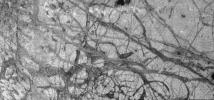
|
|
Europa ("yoo ROH puh") is the sixth of Jupiter's known satellites and the fourth largest; it is the second of the Galilean moons. Europa is slightly smaller than the Earth's Moon.
orbit: 670,900 km from Jupiter
diameter: 3138 km
mass: 4.80e22 kg
Europa was a Phoenician princess abducted to Crete by Zeus, who had assumed the form of a white bull, and by him the mother of Minos.
 Discovered
by Galileo
and Marius
in 1610.
Discovered
by Galileo
and Marius
in 1610.
Europa and Io are somewhat similar in bulk composition to the terrestrial planets: primarily composed of silicate rock. Unlike Io, however, Europa has thin outer layer of ice. Recent data from Galileo indicate that Europa has a layered internal structure perhaps with a small metallic core.
But Europa's surface is not at all like anything in the inner solar system. It is exceedingly smooth: few features more than a few hundred meters high have been seen. The prominent markings seem to be only albedo features or very low relief.
 There are
very few craters on Europa; only three craters larger than 5 km in
diameter have been found. This would seem to indicate a
young
and active surface. However, the Voyagers
mapped only a fraction of the surface at high resolution.
The precise age of Europa's surface is an open question.
There are
very few craters on Europa; only three craters larger than 5 km in
diameter have been found. This would seem to indicate a
young
and active surface. However, the Voyagers
mapped only a fraction of the surface at high resolution.
The precise age of Europa's surface is an open question.
The images of Europa's surface strongly resemble images of sea ice on Earth. It is possible that beneath Europa's surface ice there is a layer of liquid water, perhaps as much as 50 km deep, kept liquid by tidally generated heat. If so, it would be the only place in the solar system besides Earth where liquid water exists in significant quantities.
 Europa's
most striking aspect is a series of dark streaks crisscrossing the
entire globe. The larger ones are roughly 20 km across with blurred
outer edges and a central band of lighter material. The latest theory
of their origin is that they are produced by a series of volcanic
eruptions or geysers.
Europa's
most striking aspect is a series of dark streaks crisscrossing the
entire globe. The larger ones are roughly 20 km across with blurred
outer edges and a central band of lighter material. The latest theory
of their origin is that they are produced by a series of volcanic
eruptions or geysers.
Recent observations with HST reveal that Europa has a very thin atmosphere of oxygen. Of the 61 moons in the solar system only four others (Io, Ganymede, Titan and Triton) are known to have atmospheres. Unlike the oxygen in Earth's atmosphere, Europa's is almost certainly not of biologic origin. It is most likely generated by sunlight and charged particles hitting Europa's icy surface producing water vapor which is subsequently split into hydrogen and oxygen. The hydrogen escapes leaving the oxygen.

 The Voyagers
didn't get a very good look at Europa. But it is a principal focus of
the Galileo
mission. Images from Galileo's first two close encounters with Europa
seem to comfirm earlier theories that Europa's surface is very young:
very few craters are seen, some sort of activity is obviously
occuring. There are regions that look very much like pack-ice on
polar seas during spring thaws on Earth. The exact nature of Europa's
surface and interior is not yet clear but the evidence is now strong
for a subsurface 'ocean'.
The Voyagers
didn't get a very good look at Europa. But it is a principal focus of
the Galileo
mission. Images from Galileo's first two close encounters with Europa
seem to comfirm earlier theories that Europa's surface is very young:
very few craters are seen, some sort of activity is obviously
occuring. There are regions that look very much like pack-ice on
polar seas during spring thaws on Earth. The exact nature of Europa's
surface and interior is not yet clear but the evidence is now strong
for a subsurface 'ocean'.
Galileo
has found some evidence of a weak magnetic field (perhaps 1/4 of the
strength of Ganymede's).
![]() ... Jupiter ... Io
... Europa ... Ganymede ...
... Jupiter ... Io
... Europa ... Ganymede ... ![]()
![]()